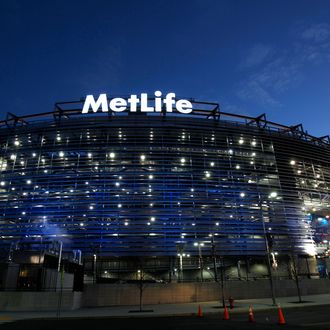
In a little over a year, MetLife Stadium in New Jersey will host Super Bowl XLVIII. MetLife Stadium, of course, doesn’t have a roof, and as you might have noticed over the past week, the weather in the greater New York area is pretty miserable this time of year. Indeed, it’ll be the first time the Super Bowl will be played outdoors in a cold-weather city. A little over a year from now, the most important football game of the year — arguably the most important American sporting event of the year — will be at the mercy of Mother Nature. Is that really such a good idea?
The process of putting a Super Bowl in the New York metropolitan area dates back to the days after 9/11. Patriots owner Robert Kraft had pushed the idea for symbolic reasons at the time, and in 2010, the New York–New Jersey bid beat out ones from Tampa and South Florida to host the game in 2014. Symbolism aside, the league’s desire to host a game in the New York area is understandable: It’s the biggest market in the country and the media capital of the world. The Super Bowl is a capital-E Event when it’s held in, say, Jacksonville, Florida. Having it in the New York area allows it to be even bigger. The league and its owners so desired it, in fact, that it was willing to push for it despite the obvious drawback of potentially nasty weather. Those are consequences they’re willing to live with.
And so let’s imagine a scenario in which the weather in East Rutherford on February 2, 2014, is cold and dreary: A low of, say, 26 degrees, with maybe a half-inch of precipitation. (It’s a reasonable scenario; those were the weather conditions at Teterboro on Februay 2, 2011.) How bad would this be, and for whom would it be a problem?
Keep in mind that the Super Bowl as a live event is really two events rolled into one. There’s a football game, in which the players compete for a championship as some lucky fans watch on from the stands. But it’s also a league marketing tool — a gathering of sponsors and suits that follows a weeklong series of parties and concerts and other events that are only tangentially related to anything that happens on a football field.
And so it goes without saying those in attendance at the game could be very uncomfortable. Hand-warmers, after all, can only do so much. But the real fans are probably the least of the league’s concerns, unfortunately, and it’s hard to feel too sorry for Verizon’s director of corporate corporateness, who in our imagination is a real person who will be given amazing seats to the game for free. Anyone attending the game is left with little choice but to suck it up. Like we said, the league is willing to live with that in order to play a game in the New York area.
But let’s at least pretend for a moment that the Super Bowl is really about football. The league is embracing the cold-weather aspect of the game, playing up the idea that football is meant to happen in the elements. In 2010, when the Jets and Giants won their joint bid to host the game, Jets owner Woody Johnson said that he hoped it would snow. And just last week, commissioner Roger Goodell said,”We’re going to celebrate the game here, we’re going to celebrate the weather and we’re going to make it a great experience.” (On the day he said this, by the way, the low at Teterboro was 10 degrees.) The league has little choice in such things: This way, if the weather’s crummy, they can spin it into a positive and get to work creating an NFL Films documentary about the Incredible Snowy Super Bowl of 2014. (They’ll come up with a catchier name, probably.) With regards to the weather next February, the NFL is hoping for the best, while also telling us that the worst isn’t really so bad.
Look, it’s true that football is played in the elements, and poor weather conditions have produced some of the league’s most iconic images: Scenes from the Ice Bowl between the Packers and Cowboys in 1967, for instance, or Tom Coughlin’s scary-looking cheeks during the NFC title game in 2008. But those games weren’t played in the cold by design. They took place in the stadiums of the home team, meaning the league had no control over where they were played. The league does have that control in the Super Bowl, which is why historically the game has been played in either warm-weather climates or indoors in cold-weather cities. We can talk all we want about how football is meant to be played in the elements, but lousy weather can make for sloppy football. Some might see beauty in forcing teams to adapt their play-calling to the conditions, but again, there’s a reason the league has avoided putting teams in such a position in the past. Just like the league is willing to live with uncomfortable fans (and sponsors) in the stands, it’s willing to risk sloppy play in its biggest game of the year, all in the name of cashing in by staging its signature event in the New York area.





























